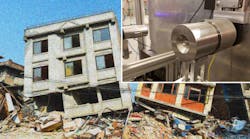High-Pressure Anvil Exerts 1.6 Billion Atmospheres Per Second to Aid with Experiments
The new-generation dynamic diamond anvil cell (dDAC) was developed by engineers at Lawrence Livermore National Laboratory (LLNL), together with some from Deutsches Elektronen-Synchroton (DESY), the European Synchrotron Radiation Facility (ESRF), and the Universities of Oxford, Bayreuth, and Frankfurt/Main. The device can compress samples faster than any similar device and turns up the pressure at a record rate of 1.6 billion atmospheres per second. It will be used for a wide range of dynamic high-pressure studies.
“For more than half a century, the diamond anvil cell or DAC has been the primary tool for creating static high pressures to study the physics and chemistry of materials under those extreme conditions,” says Zsolt Jenei from LLNL. “For example, it was used to explore the physical properties of materials at the center of the Earth at 3.5 million atmospheres.”
To simulate fast dynamic processes such as earthquakes and asteroid strikes more realistically with high compression rates in the lab, Jenei’s team developed a new generation of a dynamically-driven diamond anvil cell (dDAC). It was inspired by the pioneering efforts behind the original LLNL design and coupled to the new X-ray diffraction setup of the Extreme Conditions Beamline P02.2 at PETRA III.
The new cell consists of two small modified brilliant diamonds that get pushed together by a powerful piezo electric drive. Thanks to improvements such as much stronger piezo actuators and fast, high-peak current amplifiers, the new device can rapidly compress the tiny samples between the diamond anvils more than a thousand times faster than previous generations of dynamic diamond anvil cells.
“The dDAC will also let us characterize the response of a sample under well controlled and fast decompression,” says Earl O’Bannon from LLNL.
The new dynamic diamond anvil cell (dDAC) at the Extreme Conditions Beamline (ECB) at DESY’s X-ray source PETRA III. (Courtesy: Hanns-Peter Liermann)
To study changes in physical properties of materials under high pressure, scientists shine X-rays on the small samples and record how the material diffracts them. These diffraction patterns let scientists determine the material’s structure. However, to take snapshots of high-speed dynamic processes, the X-ray flash needs to be bright enough and the camera (detector) must be fast enough.
“For almost 10 years after the dDAC’s invention at our lab, it has been extremely difficult to conduct fast diffraction experiments because of the lack of photon flux and, more importantly, the lack of fast and highly sensitive high-energy X-ray diffraction detectors,” says Jenei. “Only through the advent of extremely bright, third-generation X-ray sources and development of highly sensitive cameras did it become possible to collect diffraction images with the adequate short exposure times and temporal resolution.”
The Extreme Conditions Beamline (ECB) at DESY has the world’s first two GaAs Lambda detectors. “By triggering them with a delay of 0.25 milliseconds, we can collect up to 4,000 frames per second,” says Hanns-Peter Liermann, the beamline scientist in charge of the ECB. The detectors were funded through a joint research project awarded by the German Federal Ministry of Education and Research BMBF to the Goethe University Frankfurt, where Björn Winkler is the principal investigator.
Researchers working on the project have demonstrated the performance and versatility of the experimental setup with fast compression studies of heavy metals such as gold and bismuth, as well as light compounds such as ice (H2O) and planetary materials such as ferropericlase. While conducting fast diffraction experiments on gold, the team demonstrated an increase in pressure from 1,000 atmospheres to 1.4 million atmospheres in only 2.5 milliseconds (thousandth of a second), resulting in a maximum compression rate of 160 terapascals per second (a terapascal is a measure of pressure). During this extremely short time, the detectors collected eight diffraction patterns across the complete compression path.
“We believe that with the existing setup we can improve the compression rates to maybe thousands of terapascals per second,” Liermann says.


